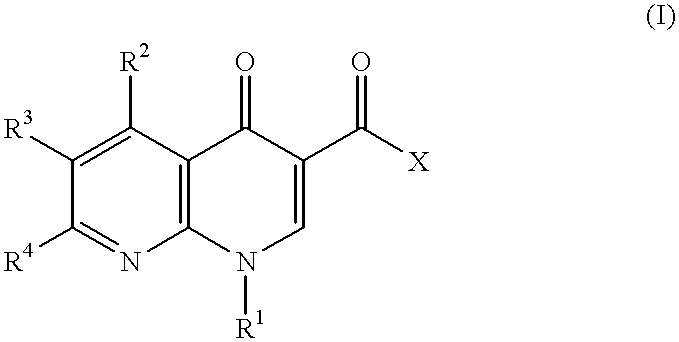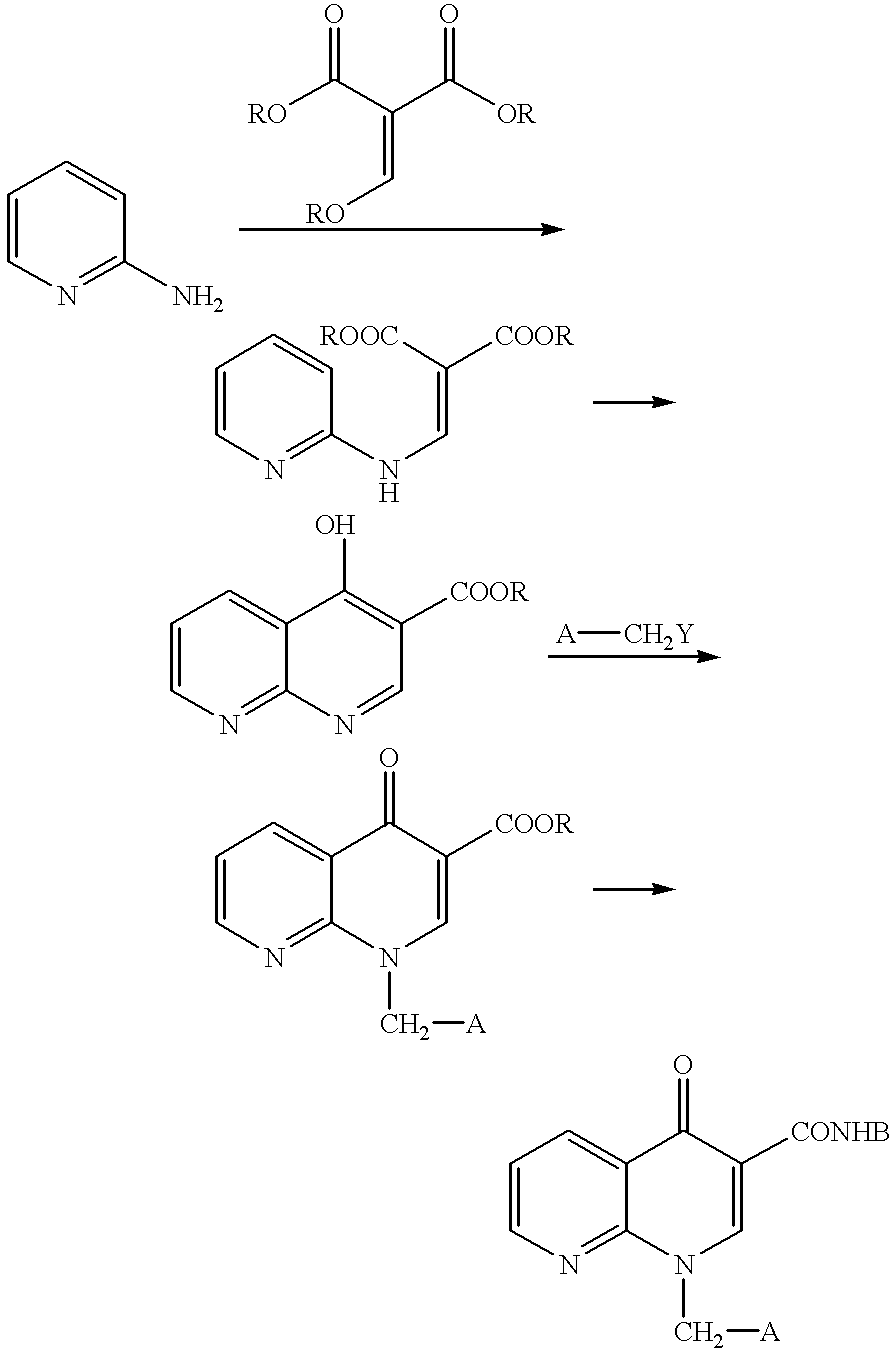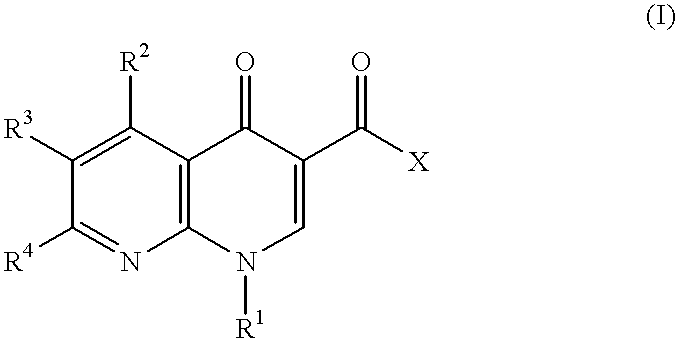1-cycloalkyl-1,8-naphthyridin-4-one derivative as type IV phosphodiesterase inhibitor
a phosphodiesterase inhibitor and cycloalkyl technology, applied in the field of 1cycloalkyl1, 8naphthyridin4one derivative as type iv phosphodiesterase inhibitor, can solve the problems of no drug which has this enzyme inhibiting action, no satisfactory medicine, and no drug has yet been developed
- Summary
- Abstract
- Description
- Claims
- Application Information
AI Technical Summary
Benefits of technology
Problems solved by technology
Method used
Image
Examples
example 1
Synthesis of (.+-.)-ethyl 3-(1-methoxycarbonylpyrrolidin-3-ylamino)-2-(2-chloronicotinoyl)acrylate
A mixed solution of 385 mg (1.69 mmol) of ethyl(2-chloronicotinoyl)acetate, 1.91 ml (20.3 mmol) of acetic anhydride and 422 .mu.l (2.54 mmol) of triethylformate was heated and stirred under an argon atmosphere at 120.degree. C. for 1.5 hours. The solution was cooled, then the excess reactants were distilled off under vacuum to obtain ethoxy acrylate. Thereafter, to a 5 ml methylene chloride solution of the ethoxy acrylate, a 2 ml anhydrous methylene chloride solution of (.+-.)-3-amino-1-methoxycarbonylpyrrolidine was added at 0.degree. C., and the solution was further stirred at room temperature for 30 minutes and then, the solvent was distilled off under vacuum. The residue was purified by silica gel column chromatography (hexane / ethyl acetate=2 / 1) to obtain 425 mg (66%) of the above-identified compound as a slightly yellow oily substance.
IR(KBr)cm.sup.-1 : 2961, 1687, 1639, 1614, 1561...
example 2
Synthesis of (.+-.)-ethyl 1-(1-methoxycarbonylpyrrolidin-3-yl)-1,4-dihydro[1,8]naphthyridin-4-one-3-carboxylate
45 mg of sodium hydride (abt. 60% oil suspension 1.13 mmol) was added to 5 ml of a tetrahydrofuran solution of 411 mg of the compound obtained in Example 1 (1.08 mmol) under an argon atmosphere at 0.degree. C. and the solution was stirred at the same temperature for 5 minutes. It was further stirred at room temperature for 30 minutes, then water (15 ml) was added and extraction was performed with ethyl acetate (30 ml). Next, the organic layer was washed with saturated saline (10 ml), then dried over anhydrous sodium sulfate, then the solvent was distilled off under vacuum. The precipitated crystal was washed with diethyl ether and the crystal was obtained by filtration to obtain 314 mg (84%) of the above-identified compound as a colorless crystal.
IR(KBr)cm.sup.-1 : 2984, 1735, 1699, 1633, 1832. MS(FAB) 346[M+H].sup.+. .sup.1 H-NMR(CDCl.sub.3): .delta. 1.41(3H, t, J=7.1 Hz) ...
example 3
Synthesis of (.+-.)-1-(1-methoxycarbonylpyrrolidin-3-yl)-1,4-dihydro[1,8]naphthyridin-4-one-3-carboxylic acid
To a mixed solution of 269 mg (0.78 mmol) of the compound obtained in Example 2 in 3 ml of tetrahydrofuran and 3 ml of ethanol, 857 .mu.l (0.857 mmol) of 1N sodium hydroxide solution was added at room temperature and the solution was stirred at that temperature for 1.5 hours. Next, this was diluted with water (20 ml) and, after washing with ether (10 ml), 1N hydrochloric acid (0.87 ml) was added to an aqueous layer. After extracting with methylene chloride (40 ml), the extract was dried over anhydrous sodium sulfate, then the solvent was distilled off under vacuum. Thus, 237 mg (96%) of the above-identified compound was obtained as a slightly yellow crystal.
MS(FAB) 318[M+H].sup.+. .sup.1 H-NMR(CDCl.sub.3): .delta. 2.36-2.65(2H, m) 3.60-3.87(3H, m) 3.76(3H, s) 4.06-4.15(1H, m) 6.13-6.23(1H, m) 7.59(1H, dd, J=4.5 and 8.0 Hz) 8.85(1H, dd, J=2.0 and 8.0 Hz) 8.90(1H, dd, J=2.0 and...
PUM
| Property | Measurement | Unit |
|---|---|---|
| temperature | aaaaa | aaaaa |
| temperature | aaaaa | aaaaa |
| temperature | aaaaa | aaaaa |
Abstract
Description
Claims
Application Information
 Login to View More
Login to View More - R&D
- Intellectual Property
- Life Sciences
- Materials
- Tech Scout
- Unparalleled Data Quality
- Higher Quality Content
- 60% Fewer Hallucinations
Browse by: Latest US Patents, China's latest patents, Technical Efficacy Thesaurus, Application Domain, Technology Topic, Popular Technical Reports.
© 2025 PatSnap. All rights reserved.Legal|Privacy policy|Modern Slavery Act Transparency Statement|Sitemap|About US| Contact US: help@patsnap.com



